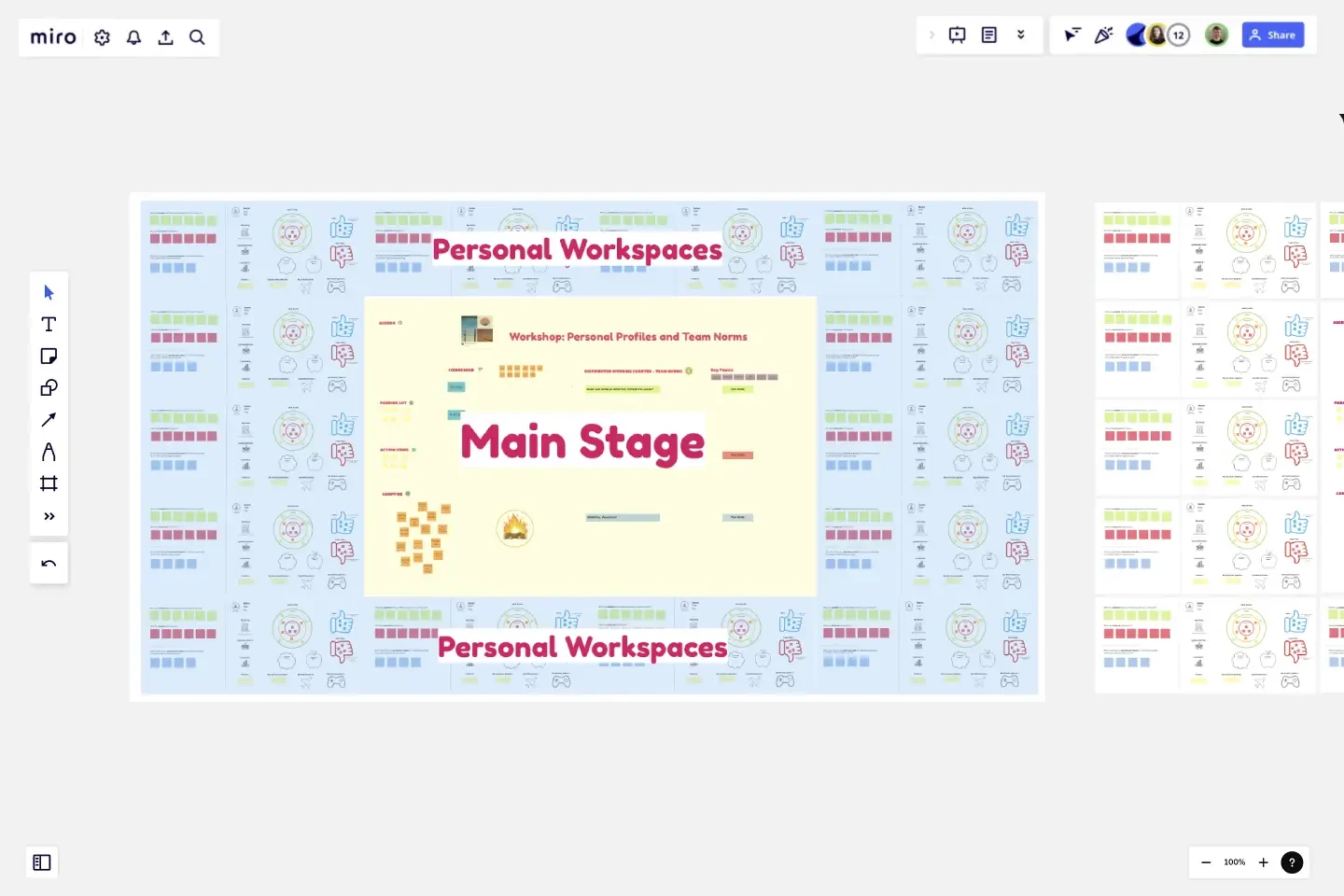Team Norms + Personal Profiles
By structuring the board with Personal Workspaces around a Main Stage, you can give your team space to create their profiles and brainstorm norms.
By structuring the board with Personal Workspaces around a Main Stage, you can give your team space to create their profiles and brainstorm norms.
How to use Team Norms + Personal Profiles
Step 1: Reflect individually on working in distributed teams.
What we did: I asked each person to write on sticky notes all of the practices that have enabled effective distributed work and those that have hindered it. Next I asked the team to identify the essential principles they felt critical when working on a distributed team.
Step 2: Group and vote on principles.
What we did: The team moved their stickies up to the main stage and began to organize them into themes. I had the group vote on the practices and principles that resonated with them the most. We then organized the top voted ones and had an open discussion about each one. Organize and discuss the top voted stickies. I asked different members of the team what each means to them? It’s also important to clarify any inconsistencies in understanding.
Step 3: Wrap up and next steps.
What we did: One of our team members volunteered to take the lead on drafting a polished version of the team’s norms. She drafted a working document and shared with the broader team for feedback and validation. The team plans to review it on a regular cadence, as norms will naturally evolve.
The Outcomes
After a one-hour guided session, we were able to create an agreed upon set of norms that the team can always refer back to and tweak if the team’s way of working evolves. The document covers everything from calendaring practices to hours of operation to meeting rituals.
Get started with this template right now.
Headcount Approval Process Flowchart
Works best for:
Flowcharts, Mapping, Diagrams
The Headcount Approval Process Flowchart template offers a visual framework for illustrating the steps and stages involved in the headcount approval process within an organization. It provides a structured framework for documenting approval workflows, roles, and decision points. This template enables HR professionals and managers to streamline the headcount approval process, ensure compliance, and improve transparency and accountability. By promoting clarity and efficiency, the Headcount Approval Process Flowchart empowers organizations to manage their workforce effectively and make informed staffing decisions.
Floor Plan Template
Works best for:
Operations, Workshops
Maybe you’re planning a big occasion or event. Or maybe you’re arranging seating structures and traffic flows that are more permanent. Either way, creating a floor plan—an overhead scaled diagram of the space—is equal parts functional and fun. This template will let you visualize how people will move about the space and know quickly if the space will do what you need, before you commit time, money, or resources. And you’ll be able to get as detailed as you want—finding the right measurements and dimensions, and adding or removing appliances and furniture.
Service Experience Observation Sheet
Works best for:
Research & Design
The Expanded Service Blueprint provides a detailed view of your service processes and interactions. This template is ideal for comprehensive service analysis and improvement. Use it to align teams, visualize the customer journey, and identify opportunities for optimization. It's perfect for enhancing service delivery, fostering collaboration, and ensuring a seamless and efficient service experience for your customers.
Cross Functional (Swimlane) Chart
Works best for:
Flowcharts, Mapping, Diagrams
The Cross Functional (Swimlane) Chart template offers a visual tool for mapping out processes or workflows with multiple stakeholders or functional areas. It provides swimlanes for organizing tasks and responsibilities by department or role. This template enables teams to visualize process flows, identify handoffs, and improve coordination and collaboration across functions. By promoting transparency and accountability, the Cross Functional (Swimlane) Chart empowers organizations to streamline workflows and drive cross-functional alignment effectively.
Pros and Cons List Template
Works best for:
Decision Making, Documentation, Strategic Planning
A pros and cons list is a simple but powerful decision-making tool used to help understand both sides of an argument. Pros are listed as arguments in favor of making a particular decision or action. Cons are listed arguments against it. By creating a list that details both sides of the argument, it becomes easier to visualize the potential impact of your decision. To make your pros and cons list even more objective, it can help to weight each pro and con against the others. You can then present your decision with confidence, making a strong argument for why it’s the right one.
Brainwriting Template
Works best for:
Education, Ideation, Brainstorming
Brainstorming is such a big part of ideation. But not everyone does their best work out loud and on the spot, yelling out thoughts and building on others’ ideas. Brainwriting is a brilliant solution for them—creative thinkers who happen to be more introverted. This approach and template invites participants to reflect quietly and write out their ideas, and then pass them to someone else who will read the idea and add to it. So you’ll get creative ideas from everyone—not just the loudest few.
